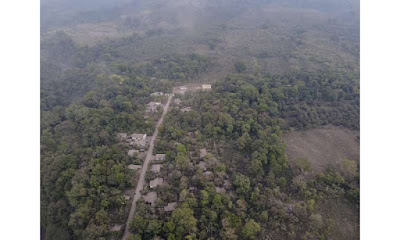added by CC from google search
Tokyo, March 9 (Jiji Press)--The Japan Meteorological Agency said Wednesday there is no fear of tsunami hitting Japan following a major volcanic eruption in Papua New Guinea.
The eruption of the Manam volcano in the South Pacific country, which occurred around 6:50 p.m. Tuesday Japan time (9:50 a.m. GMT), sent plumes of ash reaching a height of about 15 kilometers, but no change in tidal levels was recorded at overseas observation points located between Japan and Papua New Guinea as of midnight Tuesday, according to the agency.
When a major undersea volcanic eruption occurred in Tonga, also in the South Pacific area, on Jan. 15, tsunami apparently caused by atmospheric fluctuations was observed in Japan. As the tsunami reached Japan sooner than the expected arrival time for tsunami caused by an earthquake, the Japanese meteorological agency was unable to issue tsunami warnings in time for some regions. Learning from the experience, the agency reinforced its system of releasing tsunami information promptly.
*************************************************
Guatemala Volcano of Fire eruption prompts evacuations
https://phys.org/news/2022-03-guatemala-volcano-eruption-prompts-evacuations.html
https://phys.org/news/2022-03-guatemala-volcano-eruption-prompts-evacuations.html
Homes are covered by volcanic ash spewed from the Volcano of Fire, in Panimache, Guatemala, Tuesday, March 8, 2022. The National Institute of Seismology, Vulcanology, Meteorology and Hydrology said in a statement that early Tuesday the volcano's activity began to diminish.
Credit: AP Photo/Moises Castillo
About 500 residents evacuated voluntarily from the slopes of Guatemala's Volcano of Fire Tuesday as red-hot rock and ash flowed down the slopes toward an area devastated by a deadly 2018 eruption.
The National Institute of Seismology, Vulcanology, Meteorology and Hydrology said in a statement that around 3 a.m. Tuesday the volcano's activity began to diminish.
"The seismic and acoustic sensors confirm that the activity that persists in the crater are weak explosions and booms that still generate some avalanches principally toward the Ash and Dry ravines," the institute said.
Guatemala's disaster agency said shelters had been opened for the evacuees in the nearby town of Escuintla.
At one of those, a gym converted to a shelter in the community of Santa Lucia Cotzumalguapa, residents of surrounding communities rested on cots waiting to hear it was safe to return to their homes.
The 12,300-foot (3,763-meter) high Volcano of Fire is one of the most active in Central America and an eruption in 2018 killed 194 people and left another 234 missing.
The biggest danger from the volcano are lahars, a mixture of ash, rock, mud and debris, that can bury entire towns.





No comments:
Post a Comment
Stick to the subject, NO religion, or Party politics